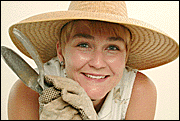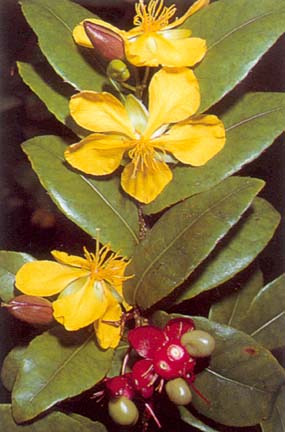Advertisement - Click to support our sponsors.


Dig This![]()
Friday, October 20, 2000

W. Arthur Whistler
In one of the hundreds of color photos in "Tropical
Ornamentals: A Guide," the Ochna thomasiana is
pictured in flower with fruit for easy identification.
Whether you like to grow tropical ornamentals or just appreciate their diverse beauty, two new books by Hawaii authors present an interesting and attractive view of these plants. Two approaches
to tropicals
Plants for Tropical Landscapes: A Gardener's Guide, by Fred D. Rauch and Paul R. Weissich; University of Hawai'i Press, 140 pages, hardcover, $39.95
For a book on tropical ornamentals written by and for green thumbs, turn to "Plants for Tropical Landscapes: A Gardener's Guide," by Fred D. Rauch and Paul R. Weissich.
Weissich, a landscape architect, was director of the Honolulu Botanical Gardens from 1957-1989. Rauch retired after 25 years as a professor and extension specialist in horticulture for the University of Hawaii.

The book is organized as a manual for landscaping. Plants are mostly grouped by their function in the garden.Sections include ground covers; small, medium and large trees and vines. Bromeliads, ferns and marantas have a separate section; as do bamboos, cycads and palms.
While propagation information is not typically included, growing conditions and patterns are the focus of the text.
Appendices include lists and advice on a range of special interest topics, including landscaping with native species, xeriscaping, beach gardening, windbreaks and the night garden.
While the photographs in "Plants for Tropical Landscapes" are smaller than those in W. Arthur Whistler's "Tropical Ornamentals: A Guide" they are plentiful (more than 700) and clear.
Tropical Ornamentals: A Guide, by W. Arthur Whistler; Timber Press, 542 pages, paperback, $34.95.
"Tropical Ornamentals" is designed more for identification than gardening, though author W. Arthur Whistler includes propagation and growing condition information for the 400 plants covered.
"I have a black thumb," said Whistler, a taxonomist who specializes in Pacific Basin plants. Having recently bought a house, however, he's glad he included some gardening information. "I'm looking through my book to see which ones are the easiest to maintain."
Whistler's goal in writing the book was to help people learn more about the plants commonly seen in the tropics.

"I think it's the easiest book for identification of so many different flowers," he said. "It's comprehensive, of the common things anyway."Whistler came to Hawaii 30 years ago to earn a doctorate at the University of Hawaii.
He has spent much of the past three decades cataloging the plants of the Pacific. This is his 10th book. "I do most of my work in Samoa, Fiji and Tonga. I do some in Hawaii," he said. "You see most of the same ornamentals all through the Pacific Islands.
"My main interest is native plants, but the main things you see are ornamental plants and people always ask me what they are. So I thought I'd find out."
The scientist, whose other books touch on everything from medicinal plants to weeds, admitted a life-long love of flowers also drew him to the task.
"I've got a picture of almost every flower in Samoa, every flower in Tonga," he said.
Whistler took all the photographs for the book, which is lavishly illustrated. It is organized by scientific name and includes and index, a glossary and an identification key for finding mystery plants.
The photographs in both books represent so much of the beauty we see around our islands.
Whistler writes in his introduction, "Ornamentals are not a necessary part of human existence -- they are the dessert rather than the main course of life."
Fortunately, Hawaii gardeners seem to subscribe to the adage: "Life is short, eat dessert first."
Gardening Calendar in Do It Electric!
Stephanie Kendrick's gardening column runs Fridays in Today.
You can write her at the Star-Bulletin, P.O. Box 3080, Honolulu 96802
or email skendrick@starbulletin.com